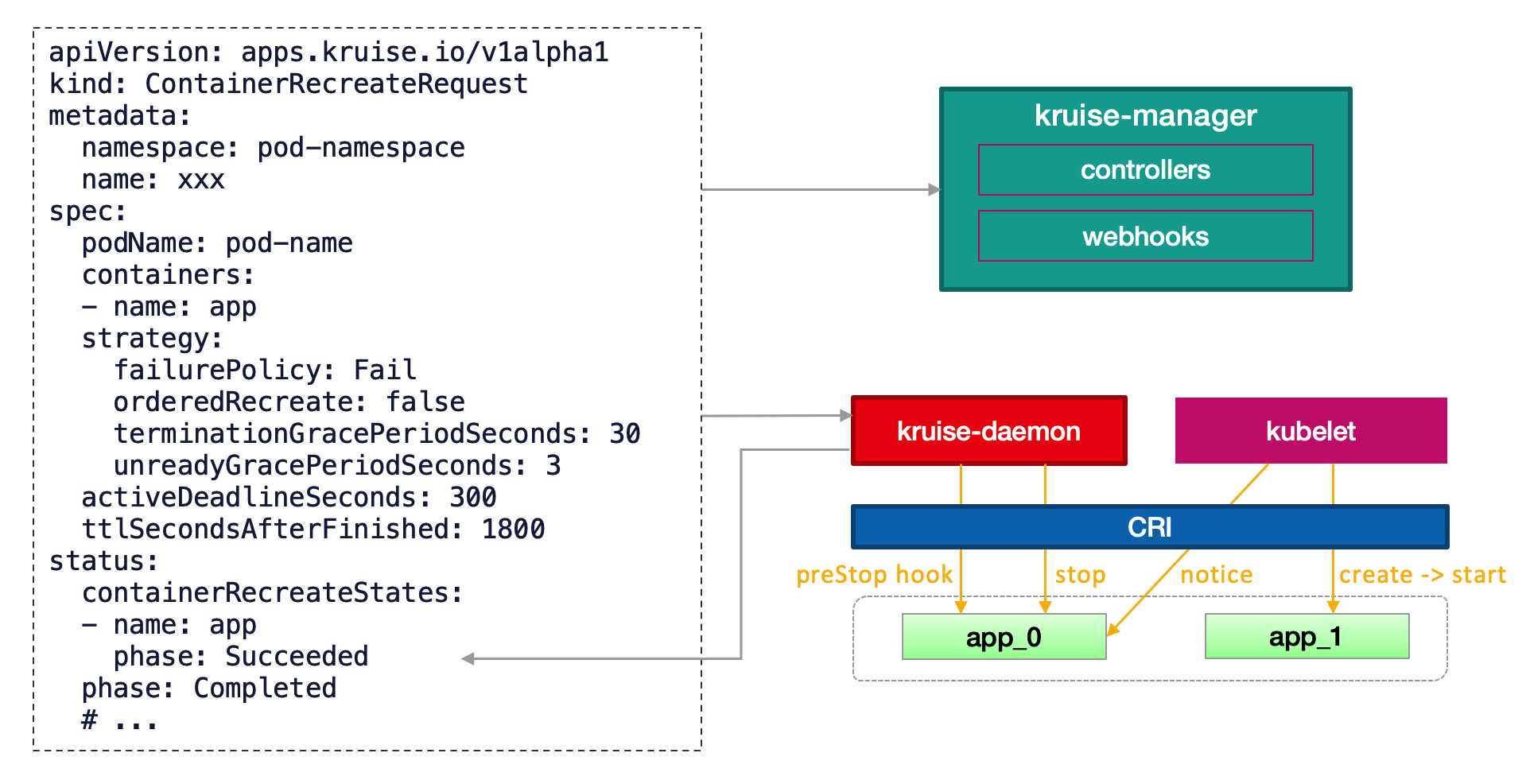Container Restart
FEATURE STATE: Kruise v0.9.0
ContainerRecreateRequest provides a way to let users restart/recreate one or more containers in an existing Pod.
Just like the in-place update provided in Kruise, during container recreation, other containers in the same Pod are still running. Once the recreation is completed, nothing changes in the Pod except that the recreated container's restartCount is increased. Note that the files written into the rootfs of the previous container will be lost, but the data in volume mounts remain.
This feature relies on kruise-daemon to stop the container in Pod.
So if the KruiseDaemon feature-gate is closed, ContainerRecreateRequest will also be disabled.
Usage
Submit request
Create a ContainerRecreateRequest (short name CRR) for each Pod container recreation:
apiVersion: apps.kruise.io/v1alpha1
kind: ContainerRecreateRequest
metadata:
namespace: pod-namespace
name: xxx
spec:
podName: pod-name
containers: # list of container name that need to be recreated, at least one
- name: app
- name: sidecar
strategy:
failurePolicy: Fail # or 'Ignore'. If 'Fail', the CRR will abort when one container failed to stop or recreate
orderedRecreate: false # 'true' indicates to recreate the next container only if the previous one has recreated completely
terminationGracePeriodSeconds: 30 # optional duration in seconds to wait the container terminating gracefully
unreadyGracePeriodSeconds: 3 # duration for the Pod is marked as not ready before its preStop hook is executed and it is stopped
minStartedSeconds: 10 # the new container will be consider as Succeeded only if it has started over minStartedSeconds
activeDeadlineSeconds: 300 # the CRR will be marked as Completed immediately if it has ran over deadline duration since created
ttlSecondsAfterFinished: 1800 # the time CRR remain as completed before the CRR is deleted
All fields in strategy and the activeDeadlineSeconds/ttlSecondsAfterFinished in spec are optional.
- Typically, containers in list will be stopped one by one, but they may be recreating together, unless the
orderedRecreateistrue. - The
unreadyGracePeriodSecondsdepends on a new feature-gate namedKruisePodReadinessGate, which indicates to inject a readinessGate during each Pod creating. OtherwiseunreadyGracePeriodSecondscan only work for those new Pods created by Kruise that have the readinessGate. - If users set
ttlSecondsAfterFinished, then CRR will automatically be deleted after completed over this time. Otherwise, users have to delete the CRR manually.
# for commandline you can
$ kubectl get containerrecreaterequest -n pod-namespace
# or just short name
$ kubectl get crr -n pod-namespace
FEATURE STATE: Kruise v1.4.0
When creating CRR resources, if the container is still in the process of starting, CRR will not restart the container again. If you want to force a container restart, you can use the following field:
apiVersion: apps.kruise.io/v1alpha1
kind: ContainerRecreateRequest
spec:
...
strategy:
forceRecreate: true # ForceRecreate indicates whether to force kill the container even if the previous container is starting.
Check request status
Status of CRR looks like this:
status:
completionTime: "2021-03-22T11:53:48Z"
containerRecreateStates:
- name: app
phase: Succeeded
- name: sidecar
phase: Succeeded
phase: Completed
The status.phase can be:
Pending: the CRR waits to be executedRecreating: the CRR is executingCompleted: this CRR has completed, andstatus.completionTimeis the timestamp of completion
Note that status.phase=Completed does not mean all containers in CRR have recreated successfully.
Users should find the information in status.containerRecreateStates.
The status.containerRecreateStates[x].phase can be:
Pending: this container waits to recreateRecreating: this container is recreatingFailed: this container has failed to recreateSucceeded: this container has succeeded to recreate
When the CRR has completed, only the containers in Succeeded phase are successfully recreated.
Implementation
When users create a CRR, Kruise webhook will inject the current containerID and restartCount into spec.containers[x].statusContext.
And, when kruise-daemon starts to execute, it will skip the container if its containerID is not equal to the one in statusContext or the restartCount has been bigger,
which means the container has already been recreated (maybe by in-place update).

Typically, kruise-daemon will stop the container with or without preStop hook, then kubelet will create a new container and start again.
Finally, kruise-daemon will report the container phase as Succeeded only if the new container has started over minStartedSeconds duration.
If the recreation occurs with an in-place update in the same time:
- If Kubelet has stopped or recreated the container because of in-place update, kruise-daemon will consider it already recreated.
- If kruise-daemon stops the container, Kubelet will keep to in-place update the container to the new image.
If multiple ContainerRecreateRequests are submitted for one Pod, they will be executed one by one.